1 Introduction
With the rapid development of global sports, the gender gap is gradually narrowing in major international events. The Paris 2024 Olympic Games, which for the first time achieved full parity in the number of male and female athletes, marked a new level of gender equality in global sport, a change that is also closely linked to the continued advancement of feminism globally. Meanwhile, social media platforms have become increasingly influential in shaping the image of athletes, emerging as a significant force beyond the scope of traditional media. As such, Xiaohongshu showcases the diverse images of female athletes, and redefines how the public perceives and constructs the image of sports stars through its immediacy and highly interactive nature. It breaks the monopoly of traditional media on the image of athletes, so that the image of athletes is no longer a one-way process dominated by a few media, but a dynamic process formed through extensive user participation and feedback. Through this two-way interaction, the images of female athletes on social media can become more diversified, including both the self-image they actively present and the influence shaped by external others. In this paper, two female athletes, Sun Yingsha and Zheng Qinwen, are selected as research subjects, focusing on their image performance on Xiaohongshu platform, combining the theories of self-creation and other-creation, and exploring the differences in their images and their formation mechanisms from the perspectives of posting content, interactive feedback, and fan participation. Through this analysis, the complex interaction between self-created and other-created images on social media platforms and its far-reaching impact on female athletes’ media image formation are further revealed.
2 Literature Review
2.1 Theories Related to Image Building
Walter Lippmann has put forward the theory of “The Real Environment” and “The Pseudo-Environment” in his book Public Opinion. He argues that human beings live in real and virtual environments, and that many of their views come not from direct experience, but from the “pseudo-environment” created by mass media [1]. In other words, Xiaohongshu, as an emerging social media platform, allows users to create a virtual world with certain values recognized by the public through posting, commenting, and liking. The mass-mediated image-creation process of recognizing athletes through their body movements, language, behavior, and personality can be called “other-creation”. However, the image of female athletes also includes their self-presentation through their own social accounts, interviews, and so on. This act of athletes actively creating an image through the active transmission of consciousness can be called “self-creation”. People are able to express themselves in such a way as to influence this qualification by means of a certain impression that he gives to others, which leads them to act voluntarily in accordance with their intentions [2]. More precisely, life can be understood as a continuous performance, where the main goal of this performance is to shape and maintain an ideal self-image in the minds of others. Performance functions as a strategic tool to convey one’s intended self-perception, thereby influencing how the external world perceives and evaluates the individual. The other-created image is the outcome of this process, a constructed impression based on how others interpret the individual’s actions. For example, when one uses a dialect in conversation, others will naturally associate them with the cultural or regional background of that dialect. This attribution process forms the basis of the other-created image, highlighting the dynamic interaction between self-created and other-created images in social contexts.
2.2 Theories Related to Social Media
As early as 2007, Anthony Mayfield made a preliminary definition of social media in his book What is Social Media, which regarded it as an emerging network medium, emphasized that it gives users great space for participation, and pointed out that its core features include participation, openness, interactivity, dialogue, community, and connectivity [3]. These attributes not only highlight the uniqueness of social media in information dissemination, but also underscore its key role in shaping social relations and cultural identity. As a social platform with no obvious participation threshold, Xiaohongshu is designed to break the one-way communication mode of traditional media, and through the search and recommendation mechanism, it enables the content posted by users to be rapidly disseminated and integrated into the public eye. This mechanism not only facilitates the wide circulation of information, but also creates a highly interactive community environment, promoting the intertwining of group identity and individual expression. The community and information flow demonstrated by Xiaohongshu provide the basis for the formation of a large and diverse fan base on the platform, which promotes interaction and content co-creation among users from different backgrounds. In this context, the persuasive power of social media has become more and more significant. Persuasion is typically understood as “communication activities aimed at influencing the beliefs, attitudes, or behaviors of others” [4]. In the social media environment, this influence comes from both the content of the message itself and the user participation in the dissemination process. For example, when user A posts a video of Sun Yingsha’s table tennis match on Xiaohongshu and highly praises her skills in the comments, the posting can gain wide recognition through likes and comments. This recognition not only enhances Sun Yingsha’s personal brand image, but creates a collective identity on the platform, further consolidating her public image as an outstanding table tennis player. This also reveals the complexity and diversity of social media in shaping the image of public figures.
3 Methodology
In this paper, content analysis and database analysis were selected as methods to explore the mediated image of female athletes on Xiaohongshu.
3.1 Sample Selection
3.1.1 Main Subjects
Sun Yingsha and Zheng Qinwen were selected as the main subjects due to their outstanding achievements in the Paris Olympics. Sun Yingsha won three medals for the Chinese delegation in table tennis, demonstrating her outstanding athletic level and psychological quality, while Zheng Qinwen made history in women’s tennis singles, becoming the first Asian athlete to win the gold medal in this event. Their achievements not only highlight their respective sports, but significantly enhance the visibility and influence of female athletes on the global stage. Based on their outstanding performance, these two athletes have a high search volume on Xiaohongshu, showing wide public attention and research value. In selecting the samples, the impact of the athletes on Xiaohongshu was focused on to ensure that the findings reflect the media image of female athletes. In addition, the decision to select the two athletes also took into account their popularity and representativeness, with the aim of exploring how they portray themselves in different media environments and their inspirational significance for women’s sports.
3.1.2 Platform Features
According to the Xiaohongshu 2024 Active Users Report, the platform has a gender ratio of 2:8, with female users dominating, making it an ideal venue to study the media image of female athletes. However, Zheng Qinwen lacks an official Xiaohongshu account, while Sun Yingsha’s account is mainly used for commercial advertisement co-operation, failing to fully demonstrate her personal attributes and opinions. In this case, the relative lack of self-expression channels on Xiaohongshu for both athletes limits their opportunities to shape their personal brands and participate in public discussions. Thus, this study focuses on analyzing the two athletes’ other-image shaping on Xiaohongshu, paying attention to how they present their images through external media and their impact on public perception. Against the backdrop of a lack of self-modeling channels, it explores how their mediated images are constructed and the significance of this construction on the overall image of female athletes. This analysis will not only help to understand the performance of individual athletes in the media environment, but also provide an important perspective to further explore the media strategies of female athletes.
3.2 Data Collection
According to the operation mechanism of Xiaohongshu, posts with a higher number of likes usually have a stronger spread and interactivity. Therefore, this study took the following steps to collect data: first, a new account was registered to exclude the algorithmic recommendation mechanism, and then the names “Sun Yingsha” and “Zheng Qinwen” were entered into the search box. Second, in the search results, the filtering mechanism of Xiaohongshu was used to select the posts with the highest number of likes, and the top 30 posts of each athlete were selected, totaling 60 posts for analysis. In order to minimize the impact of account weighting on the data, content posted by official accounts was removed, thus maximizing the exclusion of possible bias. Data collection was completed on September 1, 2024 to minimize the impact of time factors on the data.
3.3 Data Analysis Methods
This study adopts content analysis and thematic analysis methods. In terms of content analysis, a qualitative analysis of the selected 60 postings was conducted, using a discourse analysis model covering the five dimensions of title, label, content, comment and heat, to reveal the main viewpoints and emotional colors involved in the postings, so as to provide contextual support for the understanding of media images. In terms of thematic analysis, the 60 postings were categorized according to the thematic ideas extracted from the content analysis, and the postings were classified into four thematic categories, namely, competition videos, female-oriented videos (athletes’ personal achievement or emotional expression), couple pairing (CP) marketing (bundled marketing with other celebrities), and non-CP-oriented marketing (entertainment marketing after exclusion of CP marketing). By counting the frequency of different thematic categories, the media images of Sun Yingsha and Zheng Qinwen on Xiaohongshu and their influence on audiences can be comprehensively explored.
4 Results
Xiaohongshu receives personalized content recommendations based on their interests and needs. This highly personalized way of consuming content makes it easier for users to develop a sense of comparison and identification during use [5]. As a result, cognition creates a certain tendency in the same topic. The posting contents of Sun Yingsha and Zheng Qinwen each have their own characteristics. In Sun Yingsha’s posting content in Xiaohongshu, entertainment marketing occupied 23 posts, accounting for 77%, of which CP-oriented marketing in entertainment marketing appears 10 times, accounting for 33.33%. On the contrary, Zheng Qinwen is the opposite of Sun Yingsha, whose videos of competitions and women’s power accounted for 67% of the videos, entertainment marketing accounted for 33% of the videos, and there was no cp-oriented marketing in the entertainment marketing. The above can be found in Figure 1.
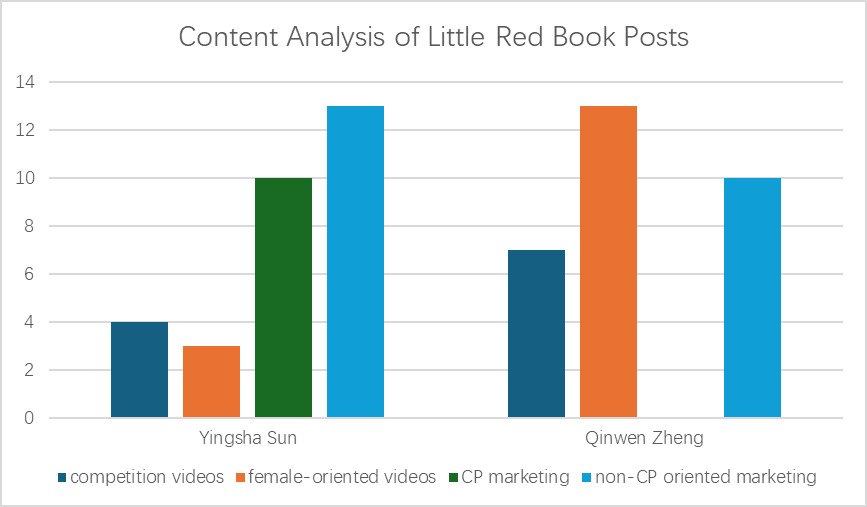
Figure 1. Specific Categories and Number of Postings on Xiaohongshu
5 Discussion
5.1 The Common Image Traits of Female Athletes on Xiaohongshu
Media image can be defined as “the collective perception of the public regarding mass media and the phenomena it presents.” In mass communication research, there are two different dimensions of media image: one dimension is the “image of the media”, referring to the image of the mass media organizations themselves, and the other dimension is the “image of people or events in the media”, which pertains to the representation of individuals and events by mass media [6]. This section primarily focuses on the second dimension, further analyzing the common characteristics of Sun Yingsha and Zheng Qinwen’s images on the Xiaohongshu platform.
5.1.1 The Demonstration of Professional Sporting Competence in Female Athletes
For professional athletes, their competitive capability is a crucial factor in attracting public attention. For example, both Sun Yingsha and Zheng Qinwen exhibit exceptional athletic prowess in their respective fields. Sun Yingsha’s technical finesse and mental resilience demonstrated in her matches against Japanese competitors, along with Zheng Qinwen’s outstanding performance at the Olympics, contribute greatly to their professional profiles. In contrast to traditional media coverage, platforms like Xiaohongshu can provide a more vivid portrayal of female athletes’ professional abilities. Through video presentations and commentary from marketing accounts, these platforms not only effectively capture the nuances of the competition but also amplify the athletes’ strengths, hence enhancing their public persona. Moreover, this multi-faceted approach to dissemination aids in constructing a compelling image of female athletes as sports icons, increasing their visibility and influence within the broader cultural landscape.
5.1.2 The Entertainment and Communication of the Image of the Female Athlete
Due to the anonymity and hidden nature of online media, the transmission of information is characterized by exemption from liability [7]. Entertainment marketing also tends to attract greater traffic, while communicators are not responsible for the information they spread, so a large number of entertainment images appear. For example, Sun Yingsha is portrayed as a “white and soft” female; Zheng Qinwen's related postings will focus on her body aspect. It can be seen that female athletes' bodies will inevitably become the center of media coverage. Beauty, both in perception and experience, is intertwined with social and cultural activities that shape women’s identity and self-esteem. Engaging in these actions facilitates integration into the social and cultural significance of gender [8]. Conventional gender awareness continues to influence the discourse, and female athletes, despite their physical prowess and power, are tethered to the male aesthetic and lack independence.
5.1.3 The Strong Feminist Themes in Shaped Image
The postings on Xiaohongshu related to both individuals all reflect the empowerment of individual women as a group, with a strong feminist character. The titles of these posts frequently feature terms such as “Be the boss of your own story!” and “Queen Wen,” which position them as typical examples and role models for the new era of women, as shown in Table 1. These terms highlight that they are self-aware, independent individuals, contributing to the growing participation of female athletes in sports, standing out on the field, and consistently achieving excellent results.
Table 1. Female-oriented posts title statistics
Sun Yingsha |
Zheng Qinwen |
|
Be the boss of your own story! |
Wow, Zheng Qinwen, the strong female lead of this feel-good story, is absolutely incredible!!! |
I’ve been wondering why I like you so much—turns out it's because your strong, feminine energy is so captivating. |
Female power needs no definition. Stay true to yourself and shine freely! |
Historic scenes that even movies can't compare to. |
On Instagram, Zheng Qinwen is also the queen of fierce independence and freedom. |
From now on, I won't be standing on the sidelines in the big moments. |
Please, enjoy your honor to the fullest. |
It feels like she’s about to burst with energy. |
Netizens across the internet are all shouting “Queen Wen”. She truly deserves the title. |
Queen Wen! Super woman. |
|
Keep going! Zheng Qinwen! |
The GOAT. |
|
This GIF will surely give me strength in the years to come. |
||
5.2 The Different Traits of Female Athletes on Xiaohongshu
5.2.1 The Independence and Divergent Content Tendencies of Media Images
The number of posts of Sun Yingsha’s entertainment marketing is much higher than that of Zheng Qinwen’s, with most of the posts bundled with Wang Chuqin’s. On the contrary, the content of Sun Yingsha's posts has a strong convergence. On the other hand, Zheng Qinwen's postings are completely opposite, with a strong convergence in content and more consistent keywords, basically centered around “Be the boss of your own story!”, “Queen” and “Female “Power”. Zheng Qinwen’s media image on Xiaohongshu is obviously more independent.
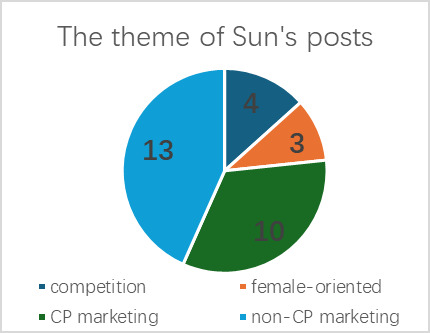
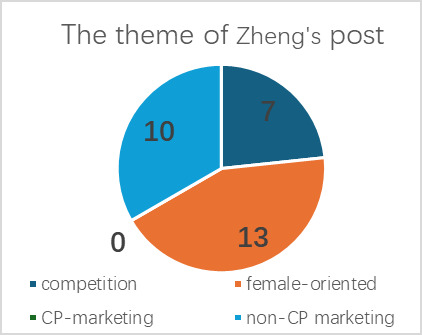
Figure 2. Comparison of the number of posts in different categories
5.2.2 Factors Behind Using Weibo as a Supportive Self-Creation Channel
Since Zheng Qinwen does not have a Xiaohongshu account and Sun Yingsha’s Xiaohongshu account is only used for business cooperation and lacks a channel for self-creation on the Xiaohongshu platform, Weibo was studied as a secondary channel for self-styling. The blog posts released by the duo’s Weibo account were used as the duo’s self-creation channel to explore the influencing factors of his shaping image. By analyzing the contents of their Weibo blog posts during the Paris Olympics, the blog posts were classified into the following two categories: advertising cooperation (mainly used for commercial purposes), Weibo official (celebratory blog posts issued by Weibo official) and self-expression (blog posts released from their own perspectives), of which Zheng Qinwen had 12 blog posts and Sun Yingsha had 11 blog posts, which were analyzed in the Figure 3. From the analysis of Zheng Qinwen’s and Sun Yingsha’s Weibo content, it is clear that their choice of Weibo as an auxiliary channel for self-creativity was influenced by several factors, including the characteristics of the platform, the positioning of their personal image, the need for commercial cooperation, and the need for emotional expression. Through the Weibo platform, they not only shaped their unique public images, but also found a suitable balance between commercialization and self-expression. This differentiated strategy demonstrates how they use the social media platform as a tool for effective self-shaping in a complex social and media environment.
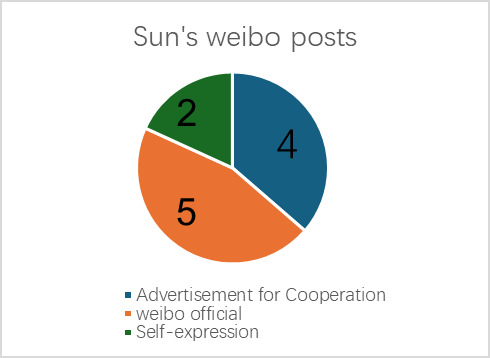
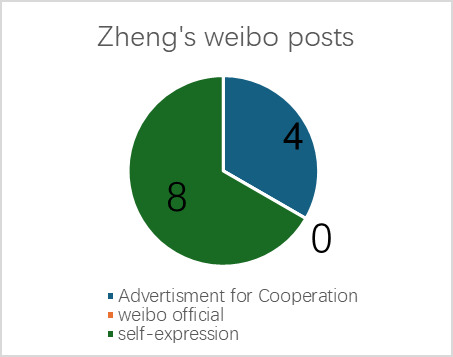
Figure 3. Comparison of the Number of Weibo Posts in Different Categories
5.2.3 The Impact of Self-Creation and Other-Creation
The greater the degree of self-creation, the more the individual’s image tends to align with their self-created persona. Sun Yingsha lacks channels to express herself on Weibo, and her every move is subject to marketing numbers going for alternative interpretations, hence leading to the misunderstanding of her relationship with Wang Chuqin. In contrast, Zheng Qinwen clearly expresses her ideas on the social media platform, such as her strong physique, passion for tennis, and confidence and self-love. She has created an image of herself as an independent and positive woman, making it difficult for marketing accounts to distort her videos or take them out of context. The other-creation image of an individual is shaped by mass media, and the media’s portrayal can influence how female athletes construct their own identities. Sun Yingsha denied her relationship with Wang Chuqin during an interview on the CCTV program Face to Face. Furthermore, during the Olympics, Luxembourg table tennis player Ni Lianxia also mentioned in a livestream that Wang Chuqin has a girlfriend. However, due to the influence of couple fans, who had already been guided by certain marketing accounts on Xiaohongshu to believe there was some connection between the two, despite clarifications from Sun Yingsha regarding her self-created image, there was no significant impact. Their fans remain one of the most active groups in the sports circle today. This phenomenon reveals the complex interaction between media and self-creation. Even though female athletes can express themselves through social platforms, the guidance of media and fan communities can still significantly influence the final presentation of their image.
6 Conclusion
The results indicate that the differences in the other-plasticized media images of female athletes on Xiaohongshu mainly stem from the fact that female athletes differed in the intensity of self-creation. The higher the degree of self-creation, the more likely the externally created image aligns with the self-created one, thus highlighting the significant role of social media in shaping personal identity. Nevertheless, this study has some limitations. It primarily focuses on the social media platform Xiaohongshu, which has a predominantly female audience, leading to narrower findings. Moreover, Xiaohongshu does not officially provide real-time rankings of post likes, meaning some posts with a high number of likes may go unrecognized. As sports and feminism evolve, the media portrayal of female athletes will be continuously reshaped by various social media platforms. Thus, the media image ultimately presented to the public is not necessarily true or objective, and it requires the audience to think critically and view it from a comprehensive perspective.
References
[1]. Lippmann, W. (2017) Public Opinion. Routledge.
[2]. Coffman, E. (1959) The Presentation of self in Everyday life. New York: Doubleday Ancher.
[3]. Mayfield, A. (2008) What is social media. Cibmtr Org.
[4]. Chen, S., Xiao, Lu, and Mao, J. (2021) Persuasion strategies of misinformation-containing posts in the social media. Inf. Process. Manag., 58:102665.
[5]. Geng, C.C. (2024). Research on the relationship between digital female images and appearance anxiety from the perspective of media studies: Take Xiaohongshu as an example. Communication & Education Review (4).
[6]. Xuan, B.J. (2009) Media image. Beijing: Communication University of China, 23.
[7]. Jiang, H. (2014) Thoughts on Standard Orientation of News Gatekeeper in the Context of Modern Media. International Conference on Science and Social Research, 810-814
[8]. Dimulescu, V. (2015) Contemporary representations of the female body: consumerism and the normative discourse of beauty, 4: 505-514.
Cite this article
Lin,Y. (2025). The Impact of Social Media on the Image of Female Athletes: The Case of Xiaohongshu. Advances in Social Behavior Research,14,63-68.
Data availability
The datasets used and/or analyzed during the current study will be available from the authors upon reasonable request.
Disclaimer/Publisher's Note
The statements, opinions and data contained in all publications are solely those of the individual author(s) and contributor(s) and not of EWA Publishing and/or the editor(s). EWA Publishing and/or the editor(s) disclaim responsibility for any injury to people or property resulting from any ideas, methods, instructions or products referred to in the content.
About volume
Journal:Advances in Social Behavior Research
© 2024 by the author(s). Licensee EWA Publishing, Oxford, UK. This article is an open access article distributed under the terms and
conditions of the Creative Commons Attribution (CC BY) license. Authors who
publish this series agree to the following terms:
1. Authors retain copyright and grant the series right of first publication with the work simultaneously licensed under a Creative Commons
Attribution License that allows others to share the work with an acknowledgment of the work's authorship and initial publication in this
series.
2. Authors are able to enter into separate, additional contractual arrangements for the non-exclusive distribution of the series's published
version of the work (e.g., post it to an institutional repository or publish it in a book), with an acknowledgment of its initial
publication in this series.
3. Authors are permitted and encouraged to post their work online (e.g., in institutional repositories or on their website) prior to and
during the submission process, as it can lead to productive exchanges, as well as earlier and greater citation of published work (See
Open access policy for details).
References
[1]. Lippmann, W. (2017) Public Opinion. Routledge.
[2]. Coffman, E. (1959) The Presentation of self in Everyday life. New York: Doubleday Ancher.
[3]. Mayfield, A. (2008) What is social media. Cibmtr Org.
[4]. Chen, S., Xiao, Lu, and Mao, J. (2021) Persuasion strategies of misinformation-containing posts in the social media. Inf. Process. Manag., 58:102665.
[5]. Geng, C.C. (2024). Research on the relationship between digital female images and appearance anxiety from the perspective of media studies: Take Xiaohongshu as an example. Communication & Education Review (4).
[6]. Xuan, B.J. (2009) Media image. Beijing: Communication University of China, 23.
[7]. Jiang, H. (2014) Thoughts on Standard Orientation of News Gatekeeper in the Context of Modern Media. International Conference on Science and Social Research, 810-814
[8]. Dimulescu, V. (2015) Contemporary representations of the female body: consumerism and the normative discourse of beauty, 4: 505-514.









